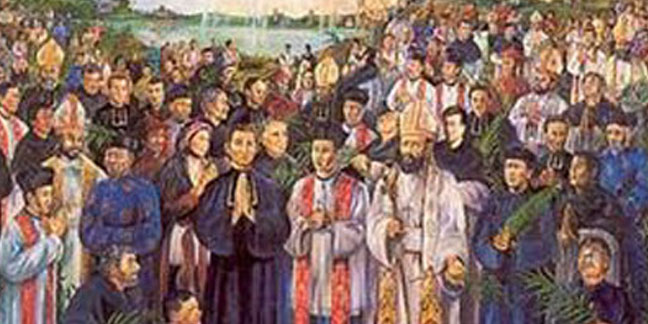On June 19, 1988, St. John Paul II canonized a group of 117 martyrs who died for the Roman Catholic faith in Vietnam between 1820 and 1862.
The Vietnamese Martyrs were made up of 96 Vietnamese, 11 Spaniards and 10 French. Eight of the group were bishops, 50 were priests and 59 were lay Catholics. Some of the priests were Dominicans, while others were diocesan priests who belonged to the Foreign Mission Society of Paris. One was a mother of six, and one was a 9-year-old child. Of the 117 martyrs, 76 were beheaded, 21 were suffocated, six were burnt alive, five were mutilated and nine died in prison as a result of torture.
St. Andrew Dung-Lac, who represents this group of heroes, was a Vietnamese diocesan priest. Born Tran An Dung in Bac-Ninh, North Vietnam, about the year 1795, he came from a poor, non-Christian family. When he was 12 the family moved to Hanoi so his parents could find work. There he met a catechist and got food and shelter from him. He also received education in the Christian faith for three years, and was baptized in Vinh-Tri. He took the name Andrew (Anrê) at his baptism.
After learning Chinese and Latin, he became a catechist, working in the missions with the priests of the Foreign Mission Society of Paris. He was chosen to study theology, and on March 15, 1823, he was ordained a priest. As parish priest in Ke-Dâm, he was tireless in his preaching. He often fasted and lived a simple and moral life, he was a good example for the people, and he baptized many people.
He was imprisoned and repeatedly tortured during the reign of Minh-Mang, emperor of Vietnam from 1820 to 1840, who was infamous for his persecutions of the Christians and often compared to Nero.
The tortures these individuals underwent are considered by the Church to be among the worst in the history of Christian martyrdom. Emperor Minh-Mang expelled all foreign missionaries and ordered Vietnamese Christians to publicly renounce their faith by trampling on a crucifix. Christian families and entire villages suffered widespread extortion or were destroyed, and teaching Christianity was forbidden. Torturers hacked off limbs joint by joint, burned people alive in bamboo cages, tore flesh with red hot tongs, and drugged people into recanting the faith. Christians left alive were branded on the face with the words "ta dao" ("false religion").
To avoid capture by the emperor's authorities, Andrew Dung changed his surname to Lac and moved to another prefecture to continue his work. But on Nov. 10, 1839, he was arrested once again, this time along with St. Peter Thi (whom he was visiting so that he might go to confession). They were freed in exchange for bribe money, but soon were arrested again and taken to Hanoi where they were tortured.
The two priests were beheaded on Dec. 21, 1839, in Hanoi.
The 117 martyrs were beatified in four groups: the first of them on May 27, 1900, by Pope Leo XIII; the second (all Dominicans) on May 20, 1906, and a third on May 2, 1909, both by St. Pius X; and the last (including two Spanish bishops) on April 29, 1951, by Pope Pius XII.
This feast day, and the witnesses of all the Vietnamese martyrs (estimated by the Church to be between 130,000 and 300,000), give testament to the sufferings inflicted on the Vietnamese Church, which are among the most terrible in the long history of Christian martyrdom.
— Sources: Catholic News Agency, www.catholicculture.org



